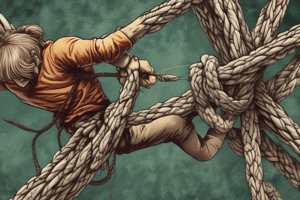Podcast
Questions and Answers
What is the primary function of a thumb knot?
What is the primary function of a thumb knot?
Which knot is best used for life-saving and rescue work?
Which knot is best used for life-saving and rescue work?
What is a characteristic feature of the figure eight knot?
What is a characteristic feature of the figure eight knot?
What is the main use of a slip knot?
What is the main use of a slip knot?
Signup and view all the answers
Which knot is specifically designed for tying together two ropes of unequal thickness?
Which knot is specifically designed for tying together two ropes of unequal thickness?
Signup and view all the answers
What is one of the uses of a clove hitch in lashing?
What is one of the uses of a clove hitch in lashing?
Signup and view all the answers
Which knot would you use for mending fishing nets?
Which knot would you use for mending fishing nets?
Signup and view all the answers
What step is necessary to tighten lashings when constructing a flag pole?
What step is necessary to tighten lashings when constructing a flag pole?
Signup and view all the answers
What is the initial step for forming a cross shape with two poles?
What is the initial step for forming a cross shape with two poles?
Signup and view all the answers
What is the purpose of wrapping turns in the lashing process?
What is the purpose of wrapping turns in the lashing process?
Signup and view all the answers
How many wrapping turns should be completed in a standard lashing procedure?
How many wrapping turns should be completed in a standard lashing procedure?
Signup and view all the answers
Which hitch is tied after the wrapping turns are completed?
Which hitch is tied after the wrapping turns are completed?
Signup and view all the answers
What is a diagonal lashing primarily used for?
What is a diagonal lashing primarily used for?
Signup and view all the answers
During diagonal lashing, which direction should the wrapping turns be initiated?
During diagonal lashing, which direction should the wrapping turns be initiated?
Signup and view all the answers
What is achieved by making the frapping turns parallel to the wrapping turns?
What is achieved by making the frapping turns parallel to the wrapping turns?
Signup and view all the answers
Study Notes
Knots and Lashings Objectives
- Provide cadets with a complete guide to 8 basic knots and 4 basic lashings.
- Prepare cadets to use knots during rescue operations.
Common Terms
- Running end: The end of the rope used during knot tying.
- Standing end: The unused portion of rope.
- Knot: The finished product of tying that secures the rope.
- Bend: A knot used to connect two ropes.
- Hitch: A knot for fastening a rope to a fixture (like a ring or spar).
- Lashing: A method for securing two or more poles using ropes.
Basic Knots for Rescue Operations
- Anchor Point knots (Bowline, Clove Hitch, Figure of Eight, Figure of Eight Follow-up, Thief Knot)
- Knots Joining Two Ropes (Single Fisherman, Double Fisherman, Sheet Bend, Water Knot, Reef Knot, Figure of Eight)
- Special Rescue Knots (Prussik Knot, Bowline with Three Loops, Bowline with Two Loops, Butterfly, Bachman, Clime Hitch)
Additional Knots and Descriptions
- Thumb Knot/Overhand Knot: Used as a temporary stopper knot to prevent rope fraying.
- Slip Knot: Adjustable loop knot useful for various purposes, including camping.
- Figure of 8 Knot: Photogenic knot, easy to learn and quick to tie, also used as a stopper in other knots.
- Fisherman Knot: Primarily used for connecting ropes of equal thickness, often for mending fishing nets.
- Reef Knot/Square Knot: Used to join two ropes of equal thickness together, commonly used in first aid.
- Bowline Knot: Essential for life-saving and rescue work due to its non-slip characteristic; also used in camping.
- Sheepshank Knot: Used to shorten a rope, particularly when fastened at both ends.
- Sheet Bend Knot: Simplest and strongest knot for joining ropes of unequal thickness, particularly for tying sails.
- Clove Hitch Knot: Used to secure a rope to a spar, rail, or a similar fitting; frequently used to start and end various lashings.
- Prussik Knot: A sliding hitch that locks onto a rope when loaded but can be moved when unloaded. The three-hitch version is generally preferred for its stability.
- Bowline on a Bight: Double loop knot tied in the bight when the two ends are unavailable.
- Carrick Bend Knot: Symmetrical, easy-to-tie, strong bend often used to connect hawsers and cables.
- Alpine Butterfly Knot: A loop knot used for rope work in rock climbing.
- Round Lashing: Used to construct a flagpole. Method involves a clove hitch, wrapping twine, and tightening for secure fastening.
- Square Lashing: Used to securely fasten two poles or spars to form a cross shape. Steps include aligning poles, attaching clove hitches, covering the poles, tightening, and locking using a second clove hitch.
- Diagonal Lashing: Designed to bind two poles together in a structure where the poles are not necessarily perpendicular. Procedure includes laying a timber hitch, subsequent wrapping, and locking with additional half hitches.
Figure of 8 Lashing
- For joining three poles that touch at the same point (e.g., a tripod).
Studying That Suits You
Use AI to generate personalized quizzes and flashcards to suit your learning preferences.
Related Documents
Description
This quiz covers essential knots and lashings that cadets must master for effective rescue operations. Learn about various knots such as the Bowline and Figure of Eight, along with techniques for securing equipment using lashings. Test your understanding of the terminology and applications of these crucial skills.




